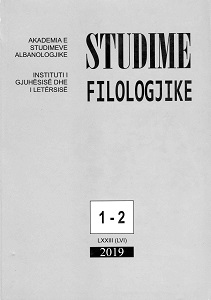Në gjurmët e një leksiku historik të shqipes: Carlo Tagliavini dhe leksema shqipe të shek. XVI-XVIII në opusin e tij
On the Traces of an Albanian Lexicon: Carlo Tagliavini and the Albanian Lexemes of the XVI-XVIII Centuries in His Opus
Author(s): Mimoza PrikuSubject(s): Language studies, Lexis, Historical Linguistics, 16th Century, 17th Century, 18th Century, Philology
Published by: Qendra e Studimeve Albanologjike
Keywords: Albanian Lexicon; Albanian Lexemes; XVI-XVIII Centuries;
Summary/Abstract: The name of the Italian linguist Carlo Tagliavini is linked with Albanological studies. The focus of his research on Albanian language is wide, but the main point of this paper will be the achievements of Tagliavini on the issue of lexical stratification. Besides his systematic work in this area (“La stratificazione del lessico albanese. Elementi indoeuropei” (Firenze, 1943, 1965) and “L’Albanese di Dalmazia” (Firenze, 1937), issues on the Albanian lexicon can also be found in other works. The purpose of our work will be the study of several Albanian lexemes of the XVI-XVIII centuries. Where did Tagliavini base his observations on the stratification of the Albanian lexicon? Undoubtedly, he relied on the old Albanian authors, but he mostly used them indirectly, mainly through the Etymological Vocabulary of Gustav Meyer, especially for the etymological source of lexemes or through published Albanian vocabularies, such as: J. Jungg (Shkodër, 1895), K. Kristoforidhi (1904), Bashkimi (Shkodër, 1908), A. Leotti (Roma, 1937), which reflect the work done for the collection of the Albanian lexicon. For special lexemes, Tagliavini used words gathered by his leader in Albanology, Norbert Jokl, from old authors. He also focused on the lexemes of the Arbnesh dialect of Borgo Erizzo in Zara, a dialect which he knew very well. Part of his work are the lexemes which mark body parts, as: asht (from Buzuku), balle (Bardhi), bark (Buzuku), buzë (Buzuku), dore (Buzuku) etc.; family relationships: atë (Buzuku), bir (Buzuku), djalë (Buzuku) etc.; animals: ari/arushë (Bardhi), dash (Buzuku) etc. These words are accompanied by etymological interpretations. Considering the evolution of Italian and the other languages, in his works Tagliavini noted the absence of a historical grammar for the Albanian language and a historical dictionary, which according to him, was not difficult to be compiled for literary Albanian, given that there exist only a relatively small number of texts. Even though Tagliavini, in co-operation with other colleagues, prepared an electronic frequency dictionary for the Italian language (“Lessico di frequenza della lingua italiana contemporanea”, Milano, 1971), the circumstances moved him slightly from Albanian language and he did not leave any evidence so that this methodology could be used for this language.
Journal: Studime Filologjike
- Issue Year: 2019
- Issue No: 01-02
- Page Range: 155-168
- Page Count: 14
- Language: Albanian

